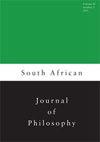The paradox of denial and mystification of machine intelligence in the Chinese room
IF 0.2
3区 哲学
0 PHILOSOPHY
引用次数: 0
Abstract
Two critical questions spun the web of the Turing test debate. First, can an appropriately programmed machine pass the Turing test? Second, is passing the test by such a machine, ipso facto, considered proof that it is intelligent and hence “minded”? While the first question is technological, the second is purely philosophical. Focusing on the second question, this article interrogates the implication of John Searle’s Chinese room denial of machine intelligence. The thrust of Searle’s argument is that a machine lacks intentionality, so it can only simulate intelligence, not duplicate it. In his thinking, whatever a machine inputs to generate an intelligent output has no bearing on humanlike intelligence. Incidentally, Searle did not classify such a machine’s output as simulated and non-intelligent, nor did he explain how this output is actualised with mere simulation. The connection between “unintelligent machine’s input” and “intelligent machine’s output” is at this point shrouded in mystery. Consequently, the more Searle attempts a denial of machine intelligence in the Chinese room, the more he mystifies it. Using the method of critical analysis, this article advances three fundamental arguments to prove a machines’ obscurity in the Chinese room thought experiment. On the ground of Searle’s conviction, the first argument queries the absurdity in bypassing intentionality to produce intelligence; the second points out the obfuscation in generating intelligence with mere computation, and the third draws attention to the dilemma of classifying a machine’s output either as real-life intelligent behaviour or simulated intelligent behaviour.中国房间里机器智能的否认与神秘悖论
图灵测试的争论围绕着两个关键问题展开。首先,适当编程的机器能通过图灵测试吗?其次,通过这样一台机器的测试,事实上,被认为是证明它是智能的,因此是“有意识的”吗?第一个问题是技术问题,第二个问题纯粹是哲学问题。围绕第二个问题,本文探讨了约翰·塞尔(John Searle)对机器智能的中国房间否定的含义。Searle的论点的主旨是,机器缺乏意向性,所以它只能模拟智能,而不能复制智能。在他看来,无论机器输入什么来产生智能输出,都与人类的智能无关。顺便说一句,Searle并没有将这种机器的输出分为模拟和非智能,他也没有解释这种输出是如何通过单纯的模拟来实现的。“非智能机器的输入”和“智能机器的输出”之间的联系在这一点上是神秘的。因此,塞尔越是试图否认中国房间里的机器智能,他就越使之神秘化。本文运用批判性分析的方法,提出了三个基本论点来证明中文室思想实验中机器的模糊性。在塞尔信念的基础上,第一个论点质疑绕过意向性来产生智性的荒谬;第二篇文章指出了仅仅通过计算生成智能的困惑,第三篇文章关注了将机器输出分类为现实智能行为还是模拟智能行为的两难境地。
本文章由计算机程序翻译,如有差异,请以英文原文为准。
求助全文
约1分钟内获得全文
求助全文
来源期刊

SOUTH AFRICAN JOURNAL OF PHILOSOPHY
PHILOSOPHY-
CiteScore
1.00
自引率
0.00%
发文量
19
期刊介绍:
The South African Journal of Philosophy (SAJP) is the official publication of the Philosophical Society of South Africa. The aim of the journal is to publish original scholarly contributions in all areas of philosophy at an international standard. Contributions are double-blind peer-reviewed and include articles, discussions of articles previously published, review articles and book reviews. The wide scope of the South African Journal of Philosophy makes it the continent''s central vehicle for the publication of general philosophical work. The journal is accredited with the South African Department of Higher Education and Training.
 求助内容:
求助内容: 应助结果提醒方式:
应助结果提醒方式:


